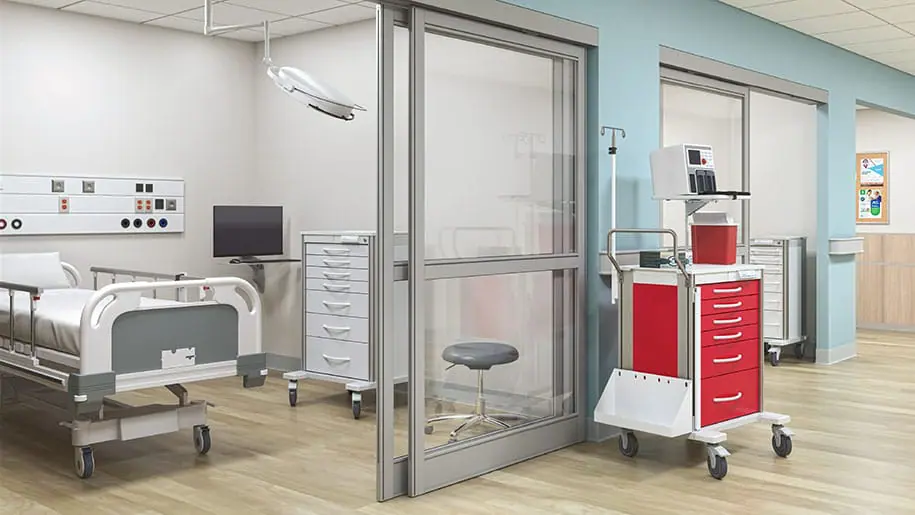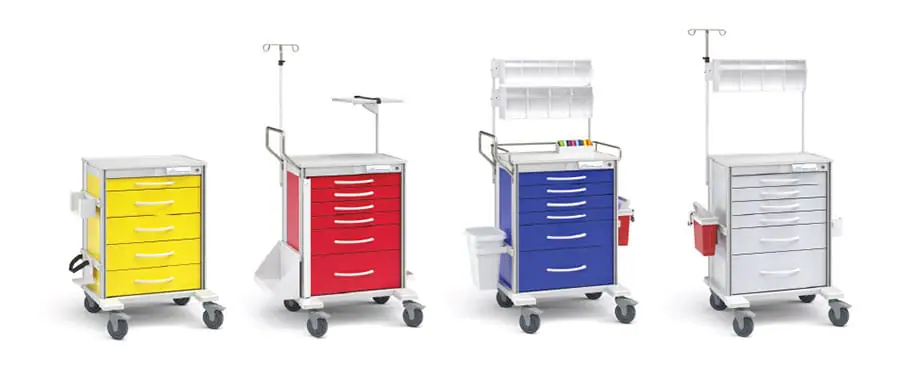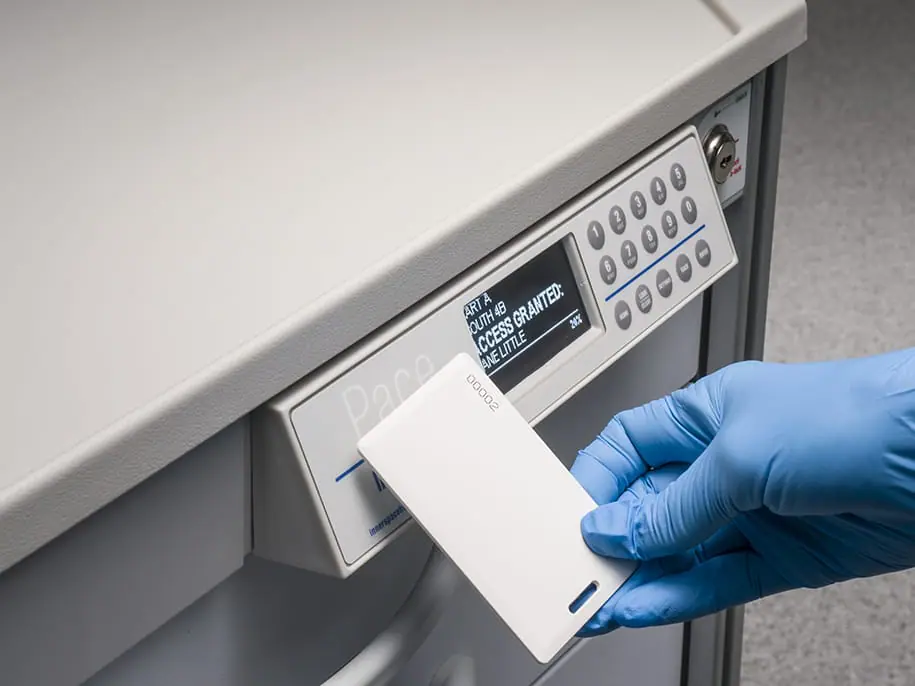Updated post from May 31, 2023

Well-designed mobile procedure carts can play a critical role in creating a safer, cleaner, and more efficient healthcare environment by supporting infection control, mobility, and workflow optimization.
Mobile carts help healthcare professionals provide fast, efficient, and safe patient care in a number of ways. A well-equipped mobile cart makes performing simple procedures at the bedside less stressful for the patient and can reduce patient transfers, resulting in less confusion and fewer errors.
Stocked with the supplies needed to meet a specific medical need, some examples of mobile procedure carts include:

- Crash carts (also known as code carts)
- Anesthesia carts
- Cast carts
- IV carts
- Isolation carts
- Medication carts
Procedure carts have drawers for supplies and may come with bins, workspaces, and rails for attaching larger equipment to the sides and front. Attachments can include trash bins, sharps containers, oxygen tanks, IV poles, and more.
For example, an anesthesia cart is usually stocked for convenience, speed, and safety, providing the necessary supplies for anesthesia professionals to care for their patients during surgeries. Other types of procedure carts operate as all-in-one workstations and supply closets, allowing healthcare staff to remain at the bedside.
Essential Features
Three essential features that every mobile procedure cart should have are adaptability, hygienic design, and security options, These features will ensure your purchase serves you well for years to come.
1. Adaptability
What is the one constant in healthcare? Change.
A configurable cart lends itself well to a changing healthcare landscape, such as when COVID-19 forced facilities to shut down entire units or convert existing units to COVID-care units. While there was never a true “COVID cart”, many existing carts were quickly converted to prevent the spread of this disease and carry supplies needed for its specific care.
Adaptable features, such as adjustable drawer dividers, optional accessory mounts, and attachable work surfaces, can turn a standard cart into an anesthesia cart, or an IV cart into an isolation cart.
Adaptability gives your mobile procedure carts longevity. Their flexibility can also prevent delays if a new type of cart must be ordered instead of re-purposing another one. Ensure adaptability is on your list of key features when making your next purchasing decision.
2. Hygienic Design
Each day in the U.S., 1 in 31 hospitalized patients is diagnosed with a healthcare-associated infection (HAI). Any medical storage purchase decision should include hygienic design considerations to help prevent HAI’s.
HAIs may result from organisms introduced during surgery or a procedure, an IV or catheter left in place for too long, exposure to pathogens during routine hospital care, or a number of other practices.
Construction Features that Make a Difference
To help reduce the risk of HAIs when choosing a cart for medical purposes, look for features that support infection-prevention measures. This means smooth surfaces, rounded corners, and sturdy materials. The construction materials should be easy-to-clean and resist chips or dents, whose nooks and crannies can harbor pathogens.
Some carts include antimicrobial work surfaces and cart interiors that can also help reduce the risk of infection. Remember hygienic design, and consider the true cost of medical storage options that prevent HAI’s compared to those that do not.
3. Security Options

Last but not least, security options should be a top consideration when choosing procedure carts. These carts may store medications, controlled substances, sharp instruments, and expensive medical devices which demand protection. Stolen drugs and medical devices cost hospitals millions of dollars each year. Black market sales or misuse of stolen items can be dangerous and cause physical harm, or worse. Lawsuits over DEA non-compliance, which include access to medications, have resulted in staggering multimillion-dollar fines.
The Critical Balance: Security with Ease of Access
Facilities need to balance the security measures used to keep medications and supplies safe with providing authorized staff easy access to these same supplies. Security is essential, but timely medical care saves lives.
A key lock or simple key code only may be needed to secure an IV supply cart, but a pharmacy cart might require a more robust locking system. The option to upgrade to a keycode plus badge swipe entry system provides better security for sensitive supplies.
Regardless of the security that is right for your facility and application, it remains a high priority when choosing medical storage of all types.
Tips for getting the most out of your mobile procedure carts
Three tips can help you get optimal use from your carts or make your final purchasing decision: stock consistently, look for sturdy, lightweight carts, and consider cart size for its purpose.
Stock consistently
If your facility has multiple carts that do the same job, like anesthesia carts or code carts, make sure each type of cart is configured and stocked the same way. When a staff member works in a different area, make their job easier by providing mobile procedure carts that are organized like the carts they’re used to using.
Look for carts that are lightweight but sturdy
No one wants to struggle with a heavy, unwieldy cart with squeaky, catchy wheels while responding to an emergency or maneuvering around people and other equipment. And a cart should never be at risk of tipping. Ensure your new carts are stable, lightweight, and glide easily.
Consider cart size
Procedure carts come in varying heights and widths for good reason. Consider where and how the carts will be used. A shorter, taller, or narrower cart may be needed.
Does it usually require storage under a counter, used as a workspace? A shorter version is a good option. Taller carts can be useful when staff frequently stand to use the top work surface, or when floor space is limited. If floor space is at a premium or hospital equipment is close together, consider narrow carts that won’t be in the way of foot traffic.
In today’s fast-paced healthcare environments, mobile procedure carts must do more than just store supplies—they must support safety, efficiency, and infection prevention. By prioritizing adaptability, hygienic design, and security, healthcare facilities can ensure their carts remain versatile, compliant, and user-friendly for years to come. Thoughtful cart selection, combined with smart stocking practices and attention to size and mobility, helps staff deliver high-quality care with confidence and ease. Your mobile procedure carts should serve your staff instead of your staff serving their carts.

Cindy Blye
Content WriterCindy Blye, BSN, RN, CCM is a Registered Nurse and Certified Case Manager. She is an Alumni of West Virginia University School of Nursing (BSN), and a member of the Association of Health Care Journalists and The Authors Guild.